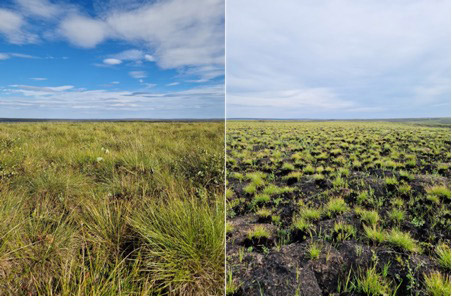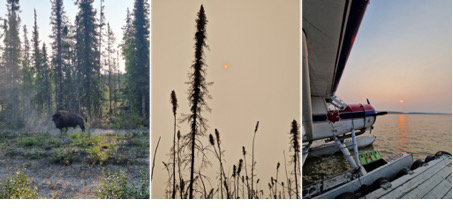After our adventures in Quebec and Greenland, it was now time for our last stop in this intense season of fieldwork. This time we were heading to the Canadian Northwest Territories (NWT). Extraordinary wildfire seasons have become a regular occurrence in the NWT. The territory’s 10-year average for the total number of fires was exceeded in 2022, with nearly 600,000 hectares burned in 256 fires. At the time, that was more than any year since the outlier season of 2014. This may seem like a lot, but 2023 was brutal and far more exceptional.
The 2023 record fire season totaled around 3.6 million hectares burned by 303 fires. About 70 percent of the territory’s population, including the capital Yellowknife, was evacuated in the summer of 2023. The current Canadian fire season is also shaping up to be one of the most extreme in the last two decades. These extreme fire seasons have a significant impact on carbon emissions into the atmosphere. In response, our goal for this campaign was to obtain critical field observations to better estimate these emissions, so we packed our bags one last time for this summer and traveled as far north as Inuvik to begin our final data collections.

Despite the significant advances in understanding carbon emissions from boreal forest fires in recent years, there are still substantial gaps in our knowledge when it comes to high-latitude tundra fires. Field-based carbon combustion measurements from tundra fires are scarce, and although these fires have historically been less frequent than those in boreal forests, they can be substantial due to the availability of carbon-rich organic soils in these regions. Part of our team on this expedition has previous field experience with tundra fires, and we know that tussocks can be used as reference points to estimate how much of the soil organic layer was lost due to fire.

In 2023, a large tundra fire broke out near the town of Inuvik. North of the Arctic Circle, the fire is in a fairly remote area with no road or river access. So, we sampled this fire by helicopter in an effort to estimate and date carbon stocks and calculate the amount of carbon released into the atmosphere. Along the fire perimeter, we found different types of dominant vegetation in the tundra, ranging from the tussocks to shrublands and even sparsely treed areas.
The view of the northern landscape was mesmerizing from above! The rolling hills stretched endlessly across the horizon, while the striking polygonal soil patterns and distinctive pingos added to the captivating view. The tundra was dotted with lakes of various sizes and ancient riverbeds. With paleo specialists Atte Korhola and Jan Weckström accompanying us, we couldn’t resist the opportunity to sample a lake and study the historical fire record preserved in its sediments. We are grateful to the Aurora Research Institute and the local community for welcoming us.

After an intense week in Inuvik, our team hit the road again, this time heading south to the Scotty Creek Research Station, about 50 kilometers from Fort Simpson. We began our journey from Yellowknife to Fort Simpson, uncertain whether the ongoing fires would allow us to travel. The smell of smoke was overwhelming, and the sight of the recently burned forest along the road was stark. Along the gravel road to Fort Simpson, we encountered bison, sampled some peatlands, and spent an hour waiting for a ferry. In the evening, we watched as the moon took on an intense red hue, tinted by the smoke particles in the air.
The next morning, we boarded a floatplane from the Mackenzie River to the Scotty Creek Research Station, where a friendly crew gave us a warm welcome. The research station is so isolated that it’s only accessible by plane. The creek, where the station is located, drains a 152-square-kilometer area of boreal forested peatland. Due to the permafrost in the region, significant thawing has transformed parts of the landscape from forested permafrost to treeless wetlands. In October 2022, the station suffered massive damage from an extraordinary late-season wildfire that raged for nearly 100 days before finally reaching the camp. The research station had just reopened during our stay there. This is good news for the entire scientific community, given the importance of this unique site in the heart of the boreal forest.

The goal of our Scotty Creek campaign was to sample the effects of fires on peatland ecosystems, aiming to better understand the climate change implications of wildfire in this fire-sensitive landscape. We spent three days in the field, sampling key ecosystems from sunrise until sunset.
A special shoutout goes to the station crew, whose professionalism made everything run smoothly. After long days of work, returning to camp was a treat, especially with our hosts preparing dinner for us. We’ll never forget their hospitality—thank you, Scotty Creek team!

And so, our journey comes to an end. It was a summer to remember, one filled with hard work but also moments of joy and discovery. People will read this post, and in the near future, others will study the findings of our field research. Our results may be cited and applied by fellow scientists. Yet, no data or paper can truly capture what this season of fieldwork was like. Only we hold those memories. The months of preparation that preceded the trip: developing research protocols, selecting sites, navigating logistics, and endless paperwork. The long hours driving both paved and dirt roads. Fieldwork under the scorching sun, and other days when cold rain chilled us to the bone. The relentless mosquitoes. Simple lunches in the field contrasted with the risotto made from mushrooms foraged at burned sites. The flat tire. The cracked car window. Lost pens. Inventorying more than 400 trees in a single plot. Charcoal covering our hands and faces day after day. Setting up camp in incredible, remote places. The joy of plunging into a cold lake after a hard day of work. Spontaneously stopping the car on our day off because the excitement of sampling two more sites was too hard to resist. Unexpectedly gaining four extra days in Greenland due to a canceled flight. Swimming in the frigid waters of a fjord. Climbing to the summit of a mountain.
We have had the privilege of visiting places most people will never see, and for that, we are deeply grateful. This chapter of fieldwork for our Ph.D. research is over, but the Arctic continues to warm, and intense fire seasons in these regions are here to stay. We are eager to better understand the complex interactions between these changes and Arctic-boreal fires. As we return home, our suitcases packed with data, the time for analyses begins—now from our offices, but with this field season always on our minds.

The NWT fires expedition was organized within the Research Council of Finland Academy Research Fellow project “Fire in the Arctic,” led by Meri Ruppel, and the Kone Foundation project FLARE. The fieldwork was also part of FireIce (Fire in the land of ice: climatic drivers & feedbacks), a Consolidator project led by Sander Veraverbeke and funded by the European Research Council. FireIce is affiliated with NASA’s Arctic-Boreal Vulnerability Experiment (ABoVE).
This blog post was co-written by Lucas R. Diaz, a Ph.D. student at Vrije Universiteit Amsterdam, and Sonja Granqvist, a Ph.D. student at the University of Helsinki, both studying Arctic-boreal fires.





Dear Dr Lucas, what an amazing adventure!! This our planet is just beautiful. Do any people live in those remote places? Did you meet them?
Thanks and congrats!
Alex
I visited the Northwest Territory in 2005 – a tour that took us from Calgary to Inuvik; we flew to Tuktoyaktuk where we saw the pingos in that area; we toured the town, waded in the ocean, climbed down into the community “freezer”, about 30 feet down in the permafrost. I’ve been wondering what has happened to the pingos and the “freezer” with the rapid warming in the Arctic. Also, the forests with their leaning trees was quite intriguing at the time (near Inuvik) – how extensive was the fire near there? We in the US barely hear anything about fires in the far north….